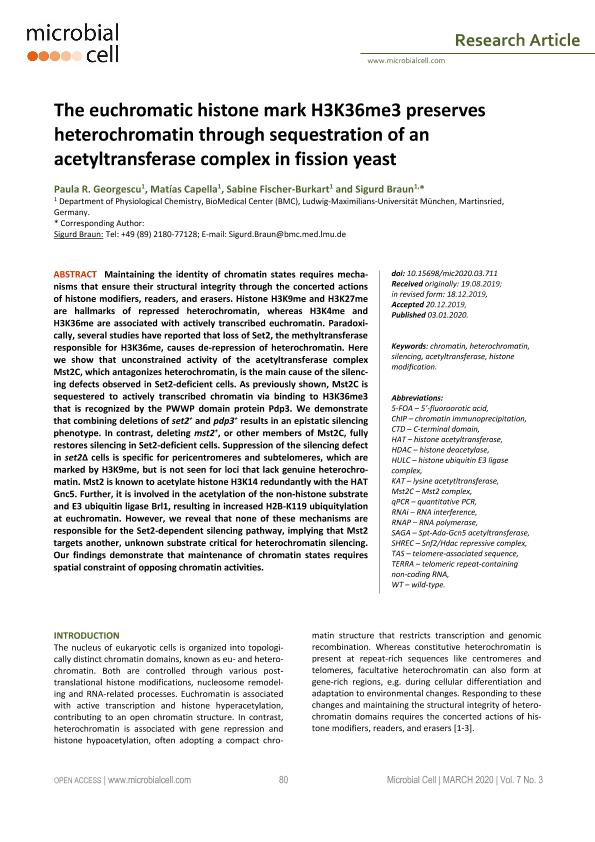Mostrar el registro sencillo del ítem
dc.contributor.author
Georgescu, Paula R.
dc.contributor.author
Capella, Matias

dc.contributor.author
Fischer Burkart, Sabine
dc.contributor.author
Braun, Sigurd
dc.date.available
2023-01-23T17:17:01Z
dc.date.issued
2020-03
dc.identifier.citation
Georgescu, Paula R.; Capella, Matias; Fischer Burkart, Sabine; Braun, Sigurd; The euchromatic histone mark H3K36me3 preserves heterochromatin through sequestration of an acetyltransferase complex in fission yeast; Shared Science Publishers OG; Microbial Cell; 7; 3; 3-2020; 80-92
dc.identifier.uri
http://hdl.handle.net/11336/185306
dc.description.abstract
Maintaining the identity of chromatin states requires mechanisms that ensure their structural integrity through the concerted actions of histone modifiers, readers, and erasers. Histone H3K9me and H3K27me are hallmarks of repressed heterochromatin, whereas H3K4me and H3K36me are associated with actively transcribed euchromatin. Paradoxically, several studies have reported that loss of Set2, the methyltransferase responsible for H3K36me, causes de-repression of heterochromatin. Here we show that unconstrained activity of the acetyltransferase complex Mst2C, which antagonizes heterochromatin, is the main cause of the silencing defects observed in Set2-deficient cells. As previously shown, Mst2C is sequestered to actively transcribed chromatin via binding to H3K36me3 that is recognized by the PWWP domain protein Pdp3. We demonstrate that combining deletions of set2+ and pdp3+ results in an epistatic silencing phenotype. In contrast, deleting mst2+, or other members of Mst2C, fully restores silencing in Set2-deficient cells. Suppression of the silencing defect in set2∆ cells is specific for pericentromeres and subtelomeres, which are marked by H3K9me, but is not seen for loci that lack genuine heterochromatin. Mst2 is known to acetylate histone H3K14 redundantly with the HAT Gnc5. Further, it is involved in the acetylation of the non-histone substrate and E3 ubiquitin ligase Brl1, resulting in increased H2B-K119 ubiquitylation at euchromatin. However, we reveal that none of these mechanisms are responsible for the Set2-dependent silencing pathway, implying that Mst2 targets another, unknown substrate critical for heterochromatin silencing. Our findings demonstrate that maintenance of chromatin states requires spatial constraint of opposing chromatin activities.
dc.format
application/pdf
dc.language.iso
eng
dc.publisher
Shared Science Publishers OG
dc.rights
info:eu-repo/semantics/openAccess
dc.rights.uri
https://creativecommons.org/licenses/by/2.5/ar/
dc.subject
ACETYLTRANSFERASE
dc.subject
CHROMATIN
dc.subject
HETEROCHROMATIN
dc.subject
HISTONE MODIFICATION
dc.subject
SILENCING
dc.subject.classification
Bioquímica y Biología Molecular

dc.subject.classification
Ciencias Biológicas

dc.subject.classification
CIENCIAS NATURALES Y EXACTAS

dc.title
The euchromatic histone mark H3K36me3 preserves heterochromatin through sequestration of an acetyltransferase complex in fission yeast
dc.type
info:eu-repo/semantics/article
dc.type
info:ar-repo/semantics/artículo
dc.type
info:eu-repo/semantics/publishedVersion
dc.date.updated
2023-01-23T00:35:28Z
dc.identifier.eissn
2311-2638
dc.journal.volume
7
dc.journal.number
3
dc.journal.pagination
80-92
dc.journal.pais
Austria

dc.journal.ciudad
Graz
dc.description.fil
Fil: Georgescu, Paula R.. Ludwig Maximilians Universitat; Alemania
dc.description.fil
Fil: Capella, Matias. Consejo Nacional de Investigaciones Científicas y Técnicas. Centro Científico Tecnológico Conicet - Santa Fe. Instituto de Agrobiotecnología del Litoral. Universidad Nacional del Litoral. Instituto de Agrobiotecnología del Litoral; Argentina. Ludwig Maximilians Universitat; Alemania
dc.description.fil
Fil: Fischer Burkart, Sabine. Ludwig Maximilians Universitat; Alemania
dc.description.fil
Fil: Braun, Sigurd. Ludwig Maximilians Universitat; Alemania
dc.journal.title
Microbial Cell
dc.relation.alternativeid
info:eu-repo/semantics/altIdentifier/doi/http://microbialcell.com/researcharticles/2020a-georgescu-microbial-cell/
dc.relation.alternativeid
info:eu-repo/semantics/altIdentifier/doi/http://dx.doi.org/10.15698/mic2020.03.711
Archivos asociados
